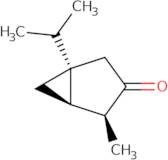Product Information
Beta-thujone is a compound that is found in plants such as sage and absinthe. It is a member of the terpene family and has significant cytotoxicity to cells. Beta-thujone binds to the GABA receptor, which is involved in neurotransmission and cell proliferation. The deuterium isotope effect was tested on sodium succinate, which resulted in an increase in beta-thujone's cytotoxicity. Beta-thujone also binds to oxygenated compounds and proteins, both of which are found in human serum and liver tissue. A solid phase microextraction technique was used to extract beta-thujone from human serum samples, while human liver tissue was extracted using a liquid phase microextraction technique.





